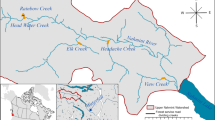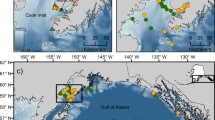Abstract
Coho salmon (Oncorhynchus kisutch) of the Southern Oregon/Northern California Coast (SONCC) Evolutionarily Significant Unit (ESU) is federally listed as a threatened species. The Trinity River Restoration Program (TRRP) is rehabilitating the Trinity River to restore coho salmon (coho) and other salmonid populations. In order to evaluate the program’s actions, several studies of movements and behavior of coho in the Trinity River were conducted from 2006 to 2009, including snorkel surveys and mark-recapture techniques based on Passive Integrated Transponder (PIT) tags, elastomer tags, and radio transmitters. Catch, recapture, and condition of natural sub-yearlings, along with site fidelity and emigration of hatchery-reared yearlings in rehabilitated and reference habitats, were studied. Location was important because coho were absent from the lower controlled and rehabilitated sites most of the time. However, rehabilitation did not have a significant effect on natural coho salmon at the site level. Apparent survival of radio-tagged, hatchery-reared yearling coho released downstream from Lewiston Dam was much lower in the first 10 km downstream from the release site than in other areas between Lewiston Dam and the Klamath River estuary. Estimated survival of yearling hatchery coho salmon per 100 km down to Blake’s Riffle was estimated at 64 % over the distance of the 239 km study area. Migration primarily occurred at night in the upper Trinity River; however, as yearlings moved through the lower Trinity River towards the Klamath River, estuary nocturnal migration became less. Apparent survival was generally lowest in areas upstream from the North Fork of the Trinity River.




Similar content being viewed by others
References
Adams N, Rondorf DW, Evans SD, Kelly JE, Perry RW (1998) Effects of surgically and gastrically implanted radio transmitters on swimming performance and predator avoidance of juvenile Chinook salmon (Oncorhynchus tshawytscha). Can J Fish Aquat Sci 55:781–787
Anderson JH, Kiffney PM, Pess GR, Quinn TP (2008) Summer distribution and growth of juvenile coho during colonization of newly accessible habitat. Trans Am Fish Soc 137(3):772–781
Beecher HA, Caldwell BA, DeMond SB (2002) Evaluation of depth and velocity preferences of juvenile coho salmon in Washington streams. N Am J Fish Manag 22:785–795
Beechie TE, Beamer L, Wasserman L (1994) Estimating coho salmon rearing habitat and smolt production losses in a large river basin and implications for habitat restoration. N Am J Fish Manag 14:797–811
Beechie TJ, Liermann M, Beamer EM, Henderson R (2005) A classification of habitat types in a large river and their use by juvenile salmonids. Trans Am Fish Soc 134:717–729
Beeman JW, Maule AG (2006) Migration depths of juvenile Chinook salmon and steelhead relative to total dissolved gas super saturation in a Columbia River reservoir. Trans Am Fish Soc 135:584–594
Beeman JW, Juhnke S, Stutzer G (2009a) Survival of migration and survival data from radio-tagged juvenile coho salmon in the Trinity River, Northern California (2008) U.S. Geol. Survey Open-File Report 2009–1092, p 26
Beeman JW, Juhnke S, Hansel H (2009b) Survival of migration and survival data from radio-tagged juvenile coho salmon in the Klamath River, Northern California (2008) U.S. Geol. Survey Open-File Report 2009–1019, p 6
Bilby RE, Fransen BR, Bisson PA, Walter JK (1998) Response of juvenile coho salmon (Oncorhynchus kisutch) and steelhead (Oncorhynchus mykiss) to the addition of salmon carcasses to two streams in southwestern Washington, U.S.A. Can J Fish Aquat Sci 55:1909–1918
Bonneau JL, Thurow RF, Scarnecchia DL (1995) Capture, marking, and enumeration of juvenile bull trout and cutthroat trout in small, low-conductivity streams. N Am J Fish Manag 15:563–568
Brakensiek KE, Hankin DG (2007) Estimating overwinter survival of juvenile coho salmon in a Northern California stream: accounting for effects of passive integrated transponder tagging mortality and size-dependent survival. Trans Am Fish Soc 136:1423–1437
Burnham KP, Anderson DR (2002) Model selection and multimodel inference: a practical information-theoretic approach. Springer Verlag, p 488
Castro-Santos T, Haro A (2003) Quantifying migratory delay: a new application of survival analysis methods. Can J Fish Aquat Sci 60:986–996
Cormack RM (1964) Estimates of survival from the sighting of marked animals. Biometrika 51(3/4):429–438
Dolloff A, Kershner J, Thurow R (1996) Underwater observation. In: Murphy BR, Willis DW (eds) Fisheries techniques, 2nd edn. American Fisheries Society, Bethesda, pp 533–554
Ebersole JL, Colvin ME, Wigington PJ Jr, Leibowitz SG, Baker JP, Church MR, Compton JE, Miller BA, Cairns MA, Hansen BP, La Vigne HR (2009) Modeling stream network-scale variation in coho salmon overwinter survival and smolt size. Trans Am Fish Soc 138:1138–1156
Garrison P, Sinnen W (2009) Juvenile coho salmon summer distribution and microhabitat utilization in the Upper Trinity River. In: Hanson L (ed) Annual report Trinity River Basin salmon and steelhead monitoring project 2006–07 season. Available from Calif. Dep. Fish. Game, 5341 Ericson Way, Arcata, Calif. 95521, pp 153–165
Hosmer DW, Lemeshow S (1999) Applied survival analysis: regression modeling of time to event data. Wiley, NY, p 386
Jeffres CA, Opperman JJ, Moyle PB (2008) Ephemeral floodplain habitats provide best growth conditions for juvenile Chinook salmon in a California river. Environ Biol Fish 83(4):449–458
Jolly GM (1965) Explicit estimates from capture-recapture data with both death and immigration-stochastic model. Biometrika 52(1/2):225–247
Kahler TH, Roni P, Quinn TP (2001) Summer movement and growth of juvenile anadromous salmonids in small western Washington streams. Can J Fish Aquat Sci 58(10):1947–1956
Katzman SM, Greathouse J, Roessig JM, Graham J, Cocherell DE, Cech JJ (2010) Water velocity preferences of coho salmon during the Parr-Smolt transformation. Environ Biol Fish 88:79–84
Koski KV (2009) The fate of coho salmon nomads: the story of an estuarine-rearing strategy promoting resilience. Ecol Soc 14(1):4, online
Lonzarich DG, Franckowiak RP, Allen MD (2009) Summer movements of juvenile coho salmon under variable stream flow conditions. Trans Am Fish Soc 138(2):397–406
Miller BA, Sadro S (2003) Residence time and seasonal movements of juvenile coho salmon in the ecotone and lower estuary of Winchester Creek, South Slough, Oregon. Trans Am Fish Soc 132:546–559
Morley SA, Garcia PS, Bennett TR, Roni P (2005) Juvenile salmonid (Oncorhynchus spp.) use of constructed and natural side channels in Pacific Northwest rivers. Can J Fish Aquat Sci 62(12):2811–2821. doi:10.1139/f05-185
Moser ML, Olson AF, Quinn TP (1991) Riverine and estuarine migratory behavior of coho salmon (Oncorhynchus kisutch) smolts. Can J Fish Aquat Sci 48(9):1670–1678
Murphy ML, Heifetz J, Thedinga JF, Johnson SW, Koski KV (1989) Habitat utilization by juvenile Pacific salmon (Onchorynchus) in the Glacial Taku River, Southeast Alaska. Can J Fish Aquat Sci 46(10):1677–1685
Naman SW, Sharpe CS (2011) Predation by hatchery yearling salmonids on wild subyearling salmonids in the freshwater environment: a review of studies, two case histories, and implications for management. Environ Biol Fish. doi:10.1007/s10641-011-9819-x, Published online 2011
Nelson RW, Dwyer JR, Greenberg WE (1987) Regulated flushing in a gravel-bed river for channel habitat maintenance: a Trinity River fisheries case study. Environ Manag 11(4):479–493
O’Neal JS (2007) Snorkel surveys. In: Johnson DH, Shrier BM, O’Neal JS, Knutzen JA, Augerot X, O’Neil TA, Pearsons TN (eds) Salmonid field protocols handbook: techniques for assessing status and trends in salmon and trout populations. American Fisheries Society, Bethesda, pp 325–339
Pess GR, Liermann MC, McHenry ML, Peters RJ, Bennett TR (2011) Juvenile salmon response to the placement of engineered log jams (ELJS) in the Elwha River, Washington state, USA River Res. Appl. [online] doi:10.1002/rra.1481
Quinn TP, Peterson NP (1996) The influence of habitat complexity and fish size on over-winter survival and growth of individually marked juvenile coho salmon (Oncorhynchus kisutch) in Big Beef Creek, Washington. Can J Fish Aquat Sci 53(7):1555–1564
Regier HA, Robson DS (1967) Estimating population number and mortality rates. In: Gerking SD (ed) The biological basis of freshwater fish production. Blackwell Science Publishing, Oxford, pp 31–66
Rogers DW (1972) King salmon (Oncorhynchus tshawytscha) and silver salmon (Oncorhynchus kisutch) spawning escapement and spawning habitat in the upper Trinity River, 1970. State of Calif
Roni P, Quinn TP (2001a) Density and size of juvenile salmonids in response to placement of large woody debris in western Oregon and Washington streams. Can J Fish Aquat Sci 58(2):282–292
Roni P, Quinn TP (2001b) Effects of wood placement on movements of trout and juvenile coho salmon in natural and artificial stream channels. Trans Am Fish Soc 130(4):675–685
Roni P, Pess G, Beechie T, Morley S (2010) Estimating changes in coho salmon and steelhead abundance from watershed restoration: how much restoration is needed to measurably increase smolt production? N Am J Fish Manag 30:1469–1484
Routledge RD (1982) The method of bounded counts: when does it work? J Wildl Manag 46(3):757–761
Seber GAF (1965) A note on the multiple recapture census. Biometrika 52:249–259
Seber GAF (1982) The estimation of animal abundance and related parameters. Macmillan, NY, p 654
Sinnen W, Kier MC, Hill A, Hileman J, Borok S (2010) Hanson L (ed) Annual report Trinity River Basin salmon and steelhead monitoring project 2007–2008 season
Sutton R, Soto T (2010) Juvenile coho salmon behavioral characteristics in Klamath River summer thermal refugia. River Res Appl. doi:10.1002/rra.1459
U.S. Fish and Wildl. Service, Hoopa Tribe (1999) Trinity River flow evaluation, final report, report of the U.S. Fish and Wildlife Service and Hoopa Tribe to the Secretary of the U.S. Department of the Interior, Washington
U.S. Fish and Wildl. Service, Bureau of Reclamation, Hoopa Valley Tribe, Trinity County (2000) Trinity River draft and final environmental impact statement/environmental impact report
White GC, Burnham KP (1999) Program MARK: survival estimation from populations of marked animals. Bird Stud 46(suppl):120–138
Acknowledgments
The studies and paper would not have been possible without assistance from Wade Sinnen; the Trinity River Restoration Program Office; Bureau of Reclamation, Denver, CO, Applied Fisheries Science Branch; Bureau of Reclamation Northern and Central California Environmental and Natural Resources Office; Hoopa Valley Tribe; Yurok Tribe; California Department of Fish and Game, Weaverville Field Office; Lewiston Fish Hatchery; U.S. Fish and Wildlife Service, Arcata Office; National Marine Fisheries Service, Arcata Office; U.S. Geological Survey, Cook, WA; Citizens and landowners of Trinity County; Richard Corwin; Mike Hamman; Don Reck; Robin Schrock; Pat Garrison; Matt See; Todd Hanna; and Tom Worcester.
Author information
Authors and Affiliations
Corresponding author
Rights and permissions
About this article
Cite this article
Chase, R., Hemphill, N., Beeman, J. et al. Assessment of juvenile coho salmon movement and behavior in relation to rehabilitation efforts in the Trinity River, California, using PIT tags and radiotelemetry. Environ Biol Fish 96, 303–314 (2013). https://doi.org/10.1007/s10641-012-9995-3
Received:
Accepted:
Published:
Issue Date:
DOI: https://doi.org/10.1007/s10641-012-9995-3




